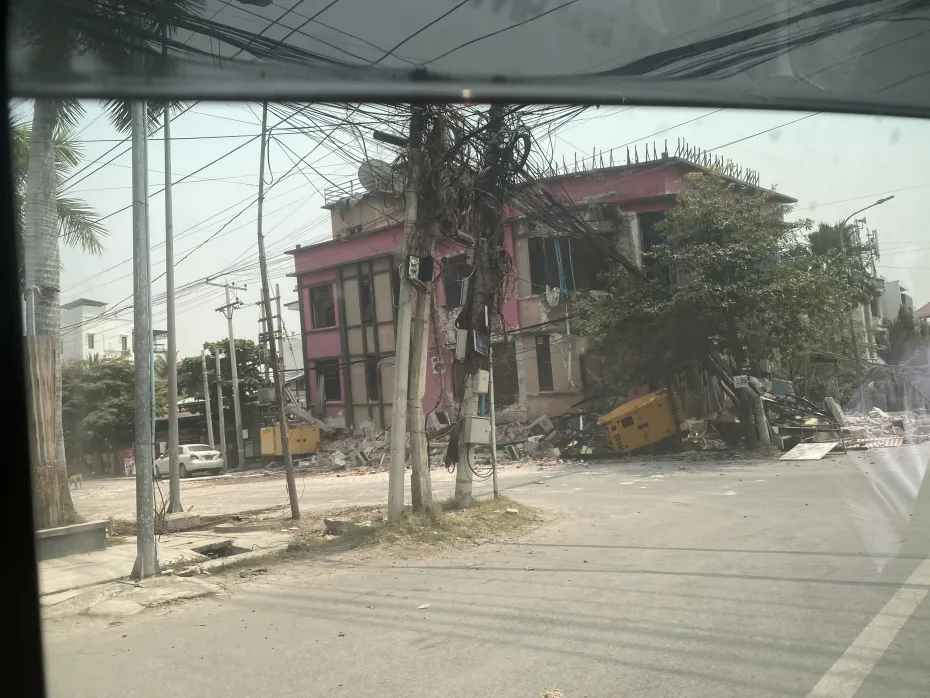On March 28, 2025, Myanmar was struck by one of the strongest earthquakes in its recent history — a magnitude 7.7 quake that devastated large parts of the country and sent shockwaves across Southeast Asia. The disaster has left hundreds dead, thousands displaced, and multiple cities in ruins, with the tremors felt as far as Thailand, Bangladesh, Laos, China, and India.
Here’s what happened, the extent of the damage, who’s affected, and what comes next.
Where the Earthquake Hit and Why It Was So Dangerous
The earthquake’s epicenter was located near Mandalay, Myanmar’s second-largest city, at a shallow depth of only 10 kilometers (6 miles). That’s what made it so deadly — shallow quakes cause more surface damage than deeper ones.
The quake hit just before dawn, jolting millions of people out of bed. Windows shattered, buildings cracked, and roads buckled. Aftershocks continued for hours, rattling nerves and further damaging structures already weakened by the initial quake.
The Human Cost: Death Toll and Injuries Rising
As of the latest updates, the official death toll has reached 144, with over 730 injured. These numbers are expected to rise significantly as rescuers continue digging through collapsed buildings.
- In Mandalay, numerous multi-story apartment buildings collapsed.
- In Toungoo, a mosque caved in during morning prayers, killing at least 20 worshipers.
- In Aungban, a hotel completely collapsed, with dozens of people trapped.
Families have been separated, and thousands are now homeless. Entire neighborhoods are in ruins.
The Earthquake’s Reach: A Regional Disaster
This wasn’t just a Myanmar problem. The earthquake shook the entire Southeast Asian region — exposing how interconnected these nations are when it comes to natural disasters.
Thailand
In Bangkok, the tremors were powerful enough to cause a high-rise under construction to collapse, killing at least nine workers. The Thai government declared a disaster response in the affected zones, and many high-rise buildings in Bangkok were evacuated as a precaution. The quake caused mass panic, with videos showing office workers and residents fleeing into the streets.
Thai meteorological agencies confirmed the quake was one of the strongest felt in Bangkok’s history, even though the epicenter was nearly 1,000 km away.
Bangladesh
The tremors reached as far as Dhaka, the capital of Bangladesh, where high-rise buildings swayed, causing brief panic and evacuations. While no major structural damage was reported, authorities issued a temporary alert for potential aftershocks and advised people to avoid old or unstable buildings.
India
In northeastern India, especially in states like Mizoram, Manipur, Nagaland, and Assam, strong tremors were reported. Many residents in Imphal and Guwahati ran out of their homes in fear. The Indian National Centre for Seismology confirmed that the quake was clearly felt across the northeast, though no serious casualties or structural collapses were reported.
China
Southwest China, particularly in Yunnan Province, also felt the tremors. The Chinese Earthquake Administration issued an immediate situation report, and while there were no reports of serious damage, some cities experienced noticeable shaking.
Laos and Vietnam
Residents in Vientiane (Laos) and parts of northern Vietnam felt light to moderate shaking. Social media posts showed office workers and families evacuating buildings. No injuries were reported, but governments in both countries reminded citizens to stay alert for possible aftershocks.
Infrastructure in Myanmar: Collapsed, Cracked, and Cut Off
Back in Myanmar, the country’s fragile infrastructure suffered a heavy blow. Key roads have been damaged or blocked by landslides. Bridges in rural regions have cracked or collapsed entirely. Power lines are down in several provinces, and communication is spotty, especially in mountainous and rebel-held regions.
In Mandalay and surrounding towns, hospitals are overwhelmed. Many are running without stable electricity, treating patients outside in parking lots and fields. Medical workers are calling for emergency supplies, including antibiotics, blood, and clean water.
A Rare Appeal from Myanmar’s Junta: Help Needed
In a significant move, the leader of Myanmar’s military government, Min Aung Hlaing, issued a formal appeal for international assistance. This is unusual, given the country’s isolation in recent years due to political sanctions and ongoing civil conflict.
The United Nations, ASEAN, and countries like India, Thailand, and China have responded with offers of help. The Red Cross, UNICEF, and Doctors Without Borders are deploying teams and resources, but many aid workers warn that rebel-controlled areas may be inaccessible.
Delivering aid will also be complicated by ongoing conflict between the military and ethnic armed groups. Logistics and safety remain serious concerns.
Stories of Survival and Strength
Amidst the chaos, stories of resilience are emerging. In Mandalay, a teacher and her students managed to escape a collapsing school by crawling through shattered windows. A mother was rescued after 10 hours trapped under rubble — holding her baby the entire time. Both survived.
Temporary shelters are springing up in open parks and fields. Volunteers are distributing food, water, and blankets to families sleeping outdoors. Children are frightened and clinging to loved ones. Elderly residents are being relocated to safer zones.
Next Steps: Rescue, Recovery, and Rebuilding
The first 72 hours after a major earthquake are the most critical. Rescue teams are racing against time to find survivors. So far:
- Over 100 aftershocks have been recorded.
- Heavy machinery is being brought in to clear debris.
- Mobile clinics are being set up.
- Engineers are inspecting bridges and hospitals for safety.
But this is just the beginning. Myanmar faces a long, painful road to recovery.
How to Help
If you want to help, consider donating to these credible organizations actively responding to the crisis:
- Red Cross Myanmar – https://www.redcross.org.mm
- UNICEF Myanmar Relief – https://www.unicef.org
- Doctors Without Borders (MSF) – https://www.msf.org
- Save the Children Asia – https://www.savethechildren.net
Even small contributions go a long way in providing emergency care, food, water, and shelter.
The Bigger Picture: A Nation on the Brink
Myanmar was already facing a deep crisis before the earthquake. The 2021 military coup plunged the country into civil war. Ethnic conflicts, economic collapse, and international isolation made things worse. Infrastructure is weak, healthcare is underfunded, and large parts of the country are controlled by resistance forces.
Now, a major natural disaster has pushed the country to the edge.
This earthquake has not only taken lives — it has exposed just how fragile Myanmar’s systems really are. The recovery will require more than donations. It will require diplomacy, humanitarian cooperation, and a willingness to look beyond politics to save lives.
Final Thoughts
Natural disasters don’t stop at borders. What began as an earthquake in central Myanmar quickly turned into a regional crisis that shook homes, families, and economies across six nations.
The world is watching. The people of Myanmar and the region need more than sympathy — they need real support, fast action, and long-term help.
We’ll keep monitoring the situation and updating this post as new information comes in.



Sources:

